Reddit Decorating A Wood Floor Room
How to Buy Wood Flooring
Here are your options in wood floor materials, plus costs and skills needed.
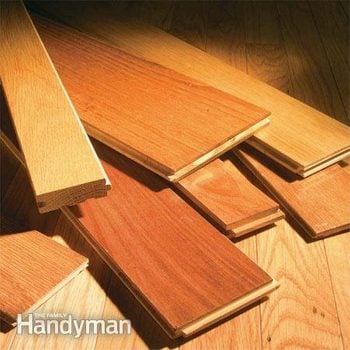 Family Handyman
Family Handyman
Learn how to size up the many types of wood floors available and make the choice that best fits your home and budget. We'll tell you the strengths and weaknesses of solid wood floors and laminated wood floors, as well as the price range and the skills you'll need if you want to install them yourself. We'll also give you expert buying advice so you can shop for your wood floor and get the best deal possible.
You might also like: TBD
- Time
- Complexity
- Cost
- Multiple Days
- Intermediate
- Varies
Project overview
Love wood floors? It's no wonder. Wood is rich looking, warm, durable and easy to keep clean. It's still the most seductive and charming type of floor in a home. But it's also a big investment, one that you'll live with for a long time. In this article, we'll tell you how to size up the many types of wood floors available and make the choice that best fits your home and budget. Most wood floors fall into two categories with unique characteristics: solid wood and laminated (layered). We'll tell you the strengths and weaknesses of each type, as well as the price range and the skills needed if you want to install them yourself. Finally, we'll include buying advice we gleaned from wood floor experts.
Solid wood flooring
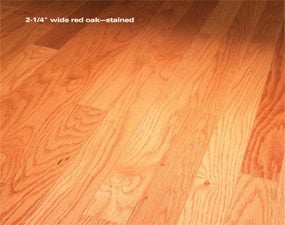
Stained 2-1/4-in.-wide solid red oak flooring
A traditional solid wood floor has random butt joints, a variety of wood grain patterns and, often, slim cracks between strips during the dry season.

Solid wood flooring
3/4-in. x 2-1/4-in. oak solid flooring has a traditional appearance that last a lifetime.

Unfinished red oak
Unfinished 3/4-in.-thick strips are nailed, sanded and finished on site, making this type of floor the most labor-intensive choice. It can be custom-stained for the exact color desired. Widely available in many grades of oak and maple, and almost any other species by special order. Cost: $3 to $5 per sq. ft. for flooring (oak) and finish; $8 to $12 per sq. ft. professionally installed and finished.
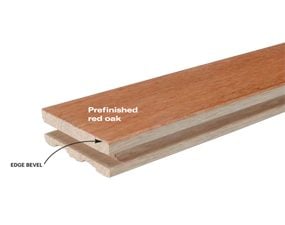
Prefinished oak flooring
Prefinished strips offer more precise milling and the slight edge bevels allow nailing without sanding. The strips have a tough, factory-applied finish in a limited choice of stains and species, mostly oak and maple. Cost: $4 to $6 per sq. ft. for flooring (oak); $8 to $12 professionally installed.

Prefinished and unfinished hardwood planks
Prefinished or unfinished planks (3/4-in.-thick tongue-and-groove boards) are available in a more limited range of hardwoods and softwoods. These sometimes require additional screws or nails to keep the floor solid. Cost: Same as other unfinished and prefinished flooring.
Solid wood flooring is usually made from 3/4-in.-thick strips, either 1-1/2- or 2-1/4 in.-wide, or sometimes 3/4-in.-thick "planks, " which are wider. It has a tongue and groove milled into the edges. When nailed through the tongues, the strips interlock to form a strong floor that feels solid underfoot. The strips are typically milled at random lengths up to about 6 ft. long. The finished floor shows random butt joints and strips displaying a wide variety of grain patterns, both traditional characteristics of a solid strip floor. A thick wear layer allows sanding and refinishing four to six times before it wears out.
Should you lay a solid wood floor yourself?

Using a floor nailer
Unfinished flooring must be sanded. You'll need to rent a flooring nailer and a sander.
Laying a solid wood floor requires some carpentry experience. You may need a power miter saw and a table saw for cutting smooth transitions to other types of flooring and for other details.
Limitations of solid wood flooring
Expands and contracts with humidity changes. Expect slight cracks to open between strips during the dry season unless you control indoor humidity year-round. The cracks will be prominent in light-colored wood.
- Must be nailed to a wood subfloor. Not ideal over concrete, since you must first add at least a 3/4-in. plywood layer as a nailing surface.
- Not suitable for damp areas.
- Expect "character" squeaks from loosened nails after a few years.
Laminated wood flooring

Laminated cherry wood floor
Laminated wood flooring is stable, excellent over concrete and easier to install than solid wood flooring.

Laminated floor board
Laminated floors consist of wood layers with narrow strips on the top that mimic solid wood strip floors.

Laminated wood planks
Laminated floors are prefinished, have precision-fitted tongues and grooves and mimic the appearance of a traditional strip floor.
Laminated floors consist of wood layers, much like plywood, with the "show" wood on the top. Don't confuse these with "laminate" floors, which have a tough plastic top layer. You can choose among a wide variety of flooring boards 3/8-in. to 5/8-in. thick, 3-in. to 8-in. wide and up to 8 ft. long. The top layer of wide boards usually consists of narrower strips to better mimic solid wood strip floors. The boards have precise tongues and grooves for tight-fitting joints. Laminated floors are prefinished in a wide range of stains. Depending on the thickness of the top "wear" layer, laminated floors can be sanded and refinished zero to four times. Material prices range from $5 to $12 per sq. ft., virtually the same as for prefinished solid strip floors.
Laminated floating floor installation technique
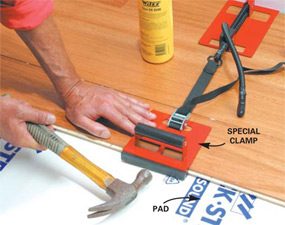
Edge-glue type floating floor installation
Lay a pad and snap or glue together floating floors. Clamps hold glued edges tight until they dry.
With the floating technique, you don't fasten the flooring to the subfloor. Rather you glue or snap the edges of the boards together to make a solid sheet that rests on a pad. This technique works well over concrete as well as wood subfloors. A floating floor must be free to expand and contract. Use special transitions to cover the edges where the floor meets carpeting, tile, stairs and other types of flooring. Buy a sound-deadening pad from a dealer; floating floors tend to be loud underfoot.
Limitations
- The joints will eventually show as a regular pattern and may affect the appearance, especially on lighter-colored floors. Butt joints will be more prominent on wide boards.
- Transition pieces can be distracting. Make sure you're comfortable with their appearance.
- Removing damaged boards in an edge-glued floor is difficult. You'll have to call in a pro.
- Some types are considered suitable for potentially damp areas—kitchens, bathrooms, basements— but there is some risk. Read the warranty carefully.
Do-it-yourself?
A floating floor is easy to lay but requires simple carpentry skills around edges and transitions. When edge-gluing, use special clamps to make sure the joints stay tight until the glue dries. Rent or buy these clamps from the flooring dealer if you do it yourself.
Glue-down laminate floor installation technique
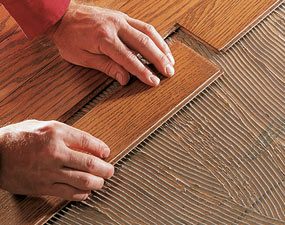
Glue-down laminate floor installation
Glue laminated strips to dry, flat subfloors much as you would do with tile.
Most types of laminated floors can be glued to a wood subfloor or dry concrete. However, when the wood contracts, a glue-down floor is more prone to gaps at the joints than a floating floor is.
Limitations
- This isn't a good choice in potentially wet or damp areas like kitchens, bathrooms and basements.
Do-it-yourself?
- Glued floors are easy to lay. Simple carpentry skills needed for transitions.
Nail-down laminate floor installation
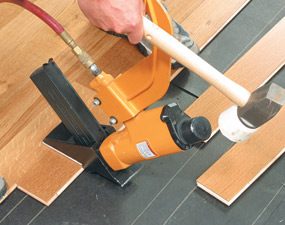
Nail down laminate floor installation
Rent a special flooring stapler designed for the flooring thickness.
Much like solid strip floors, some types of laminate flooring can be nailed (usually stapled) to solid wood subfloors.
Limitations
- Not a good choice in potentially wet or damp rooms.
- Can develop squeaks.
Do-it-yourself?
- Simple carpentry skills are needed for cutting and nailing transitions.
Wood Floor Shopping Tips
- Visit a flooring specialty store. You'll be amazed at the wide range of wood species and finishes now available. Since you buy a wood floor primarily for appearance, it's important for you to be able to examine and touch them and even walk on them to get the feel underfoot. You can also ask about other, less common types of wood flooring, including parquet, cork and bamboo.
- Ask the salesperson about the stability of the species you like. All wood floors expand and contract with humidity changes, and small gaps open between boards. If you live in an area with wide humidity swings (see map below), the gaps may be large enough to bother you. Either buy a more stable species, or a species and finish in which the gaps will be less prominent. Or plan to control your indoor humidity.
- Consider location. For example, the joints in light-colored wood will eventually show up as dark lines in high-wear areas like in an entry or kitchen. And avoid wood with beveled edges in kitchens and baths, where spilled water will collect and soak into joints.
- Remember that wood floors are not maintenance free. Clean your wood floor regularly with wood floor cleaner and a towel. Left underfoot, grit will grind off the finish. Put pads under chair and table legs.
Required Tools for this Project
Have the necessary tools for this DIY project lined up before you start—you'll save time and frustration.
You may require specialized tools depending on your installation technique. Specialized clamps are required to hold floating floors in place until the glue dries. You may have to rent a flooring nailer and a sander to install both solid and laminate wood floors.
Required Materials for this Project
Avoid last-minute shopping trips by having all your materials ready ahead of time. Here's a list.
Similar Projects
Reddit Decorating A Wood Floor Room
Source: https://www.familyhandyman.com/project/how-to-buy-wood-flooring/
Posted by: rossarman1993.blogspot.com

0 Response to "Reddit Decorating A Wood Floor Room"
Post a Comment